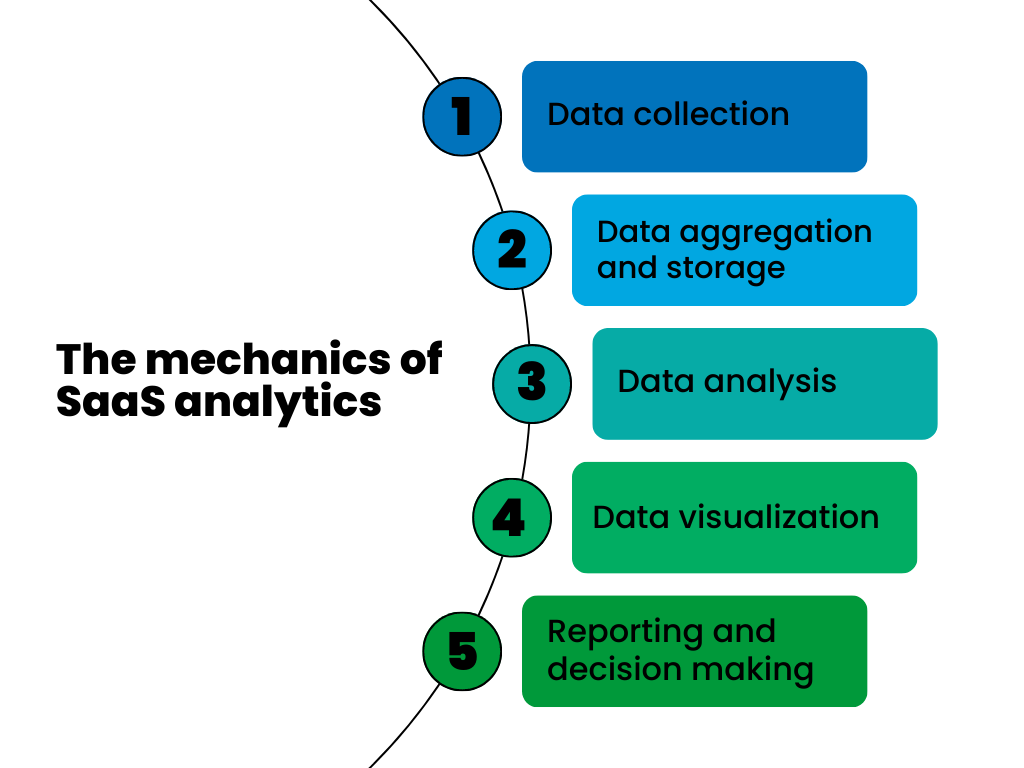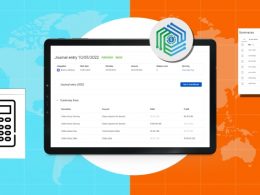In the 21st century, where digital technology profoundly influences almost all aspects of business operations, Software as a Service (SaaS) has emerged as a key player. The growing popularity of SaaS is attributed to its inherent scalability, cost-effectiveness, and the ease of implementation it offers to businesses of all sizes. However, merely incorporating SaaS into business operations is not enough. To fully utilize its potential, understanding and using SaaS analytics is crucial. This article explores the world of SaaS analytics and the importance of SaaS analytics tools for modern businesses.
Understanding SaaS analytics
SaaS analytics is a term used to describe the process of gathering, analyzing, and interpreting data related to the performance of Software as a Service (SaaS) applications. This could include metrics related to user engagement, customer behavior, application performance, and a range of other key performance indicators (KPIs).
SaaS analytics can provide valuable insights into how users are interacting with a particular software service, how well that service is performing, the effectiveness of various features, and potential areas for improvement. These insights are crucial for decision-making processes in businesses, helping them to improve user experience, enhance product functionality, optimize marketing strategies, reduce churn rate, and boost overall business performance.
Importantly, since SaaS is delivered over the internet, SaaS analytics can offer real-time or near real-time insights, enabling businesses to respond swiftly to trends or issues. This capacity is particularly valuable in today’s fast-paced business environment, where the ability to adapt quickly can be a significant competitive advantage.
The mechanics of SaaS analytics
SaaS analytics operates through a series of interconnected processes that facilitate the gathering, analyzing, and interpreting of data derived from Software as a Service (SaaS) applications. The mechanics of SaaS analytics can be broken down into several core stages:

Data collection
The initial step in SaaS analytics is data collection. SaaS applications generate an immense volume of data based on user interactions, including information about how users navigate the software, which features they use the most, how long they spend on the platform, and much more. This data is captured in real-time and forms the raw material for SaaS analytics.
Data aggregation and storage
The next stage is the aggregation and storage of data. This usually involves compiling data from different sources and storing it in a secure, accessible location (often a cloud-based database). The goal is to have a centralized, organized store of data that can be easily accessed for analysis.
Data analysis
Once data is collected and stored, the analysis can begin. This might involve various techniques, depending on the nature of the data and the business’s goals. For instance, data scientists might use statistical analysis to identify trends, machine learning algorithms to make predictions, or A/B testing to compare the effectiveness of different features. The analysis stage is where raw data is transformed into actionable insights.
Data visualization
Data visualization is crucial to SaaS analytics, as it allows complex data to be displayed in an understandable and interpretable format. This could involve creating graphs, charts, or other visual aids to illustrate trends and patterns. Good visualization helps stakeholders understand the insights derived from the data.
Reporting and decision making
The final step in the process is reporting and decision-making. This involves presenting the results of the data analysis in a clear, concise manner, often through a dashboard or report. The insights gained from the analysis can then be used to inform business decisions – whether that’s improving user experience, prioritizing product development, or redefining marketing strategies.
It’s important to note that these steps are cyclical. As new data is generated, it’s collected, analyzed, visualized, and reported on a continuous basis, providing businesses with ongoing, up-to-date insights.
Key SaaS metrics businesses should monitor
Here are the list of SaaS metrics businesses should track.
Monthly Recurring Revenue (MRR)
Among all SaaS metrics, MRR is a measure of the predictable revenue that a company can count on receiving every month. Tracking MRR gives companies a clear picture of their financial health and stability.
Annual Recurring Revenue (ARR)
Similar to MRR, ARR represents the value of the recurring revenue components of your term subscriptions normalized to a one-year period and is tied with a concept of revenue recognition.
Customer Acquisition Cost (CAC)
CAC is the total cost spent on acquiring a new customer, including expenses like marketing and sales. Keeping CAC in check is crucial to ensure that the cost of acquiring new customers doesn’t exceed their value over time.
Lifetime Value (LTV)
LTV is the projected revenue from a customer over the lifetime of their relationship with your company. This metric helps businesses understand the long-term value of their customers and assess their profitability.
Churn Rate
Churn rate is the percentage of customers who end their subscriptions within a certain time period. A high churn rate can be a red flag, indicating customer dissatisfaction or competitive disadvantages.
Net Promoter Score (NPS)
NPS measures customer satisfaction and loyalty by asking customers how likely they are to recommend your product or service. A high NPS indicates happy, loyal customers.
Active Users
This can be measured as Daily Active Users (DAU), Weekly Active Users (WAU), or Monthly Active Users (MAU). This metric provides insight into how often users are engaging with your product.
Average Revenue Per User (ARPU)
ARPU measures the revenue generated per user or unit, providing insights into revenue trends and the effectiveness of monetization strategies.
Expansion Revenue
This metric monitors the additional revenue from existing customers through upselling, cross-selling, or purchasing additional features or services.
Product Usage
Measures how often and to what extent customers are using your product. This can help identify popular features or those that may need improvement.
Introduction to SaaS analytics tools
In this sea of data that SaaS applications generate, SaaS analytics tools are the navigational compasses. These tools are specialized software applications designed to capture and analyze data from platforms efficiently. They serve several functions, from tracking user engagement and monitoring product performance to identifying trends and making accurate predictions.
When considering SaaS analytics tools, there are several key features to look for. Real-time reporting tools are vital as they ensure businesses can react quickly to any changes or issues. Data visualization capabilities can turn complex data sets into easy-to-understand charts and graphs, making insights more accessible to stakeholders.
Customizability is another important feature, as it allows businesses to tailor the tool to their specific needs. A user-friendly interface can ensure a smooth adoption process across the organization, and robust data security measures are essential in today’s world, where cyber threats are an increasing concern.
How to choose the right SaaS analytics tools
Choosing the right SaaS analytics tool for your business can significantly impact your ability to make data-driven decisions. The best tool for you depends on your specific needs, budget, and capabilities. Here are some steps you can follow to make the right choice.
Identify your needs
The first step in choosing the right SaaS analytics tool is identifying your specific needs. Are you looking to track user behavior? Do you need insights into your sales and marketing performance? Do you want to monitor application performance or focus on financial analytics? Different tools specialize in different areas, so being clear about your needs is crucial.
Evaluate the analytics tool’s capabilities
Once you have a clear understanding of your needs, you should evaluate the capabilities of various tools to see if they meet your requirements. Look at the tool’s data collection, processing, and analysis capabilities, as well as the insights it can provide.
Ease of use
The ideal SaaS analytics tool should be user-friendly. It should have an intuitive interface and make it easy for users to collect, analyze, and visualize data. Tools that offer a steep learning curve might hinder your team’s productivity.
Analytics tool integration with existing systems
Your SaaS analytics tool should be able to easily integrate with your existing systems, like your CRM, marketing platforms, and other data sources. This ensures seamless data flow and eliminates the need for manual data entry.
Scalability
As your business grows, your data analytics needs will grow too. It’s important to choose a tool that can scale with your business.
Data security
Since the tool will be handling sensitive business data, you need to ensure that it has robust security measures in place. Look for tools that offer encryption, secure data storage, and compliance with data protection regulations.
Customer support
Reliable customer support is essential. You want to ensure that if you run into any issues or have any questions, you can get the help you need.
Analytics tool pricing
Finally, consider your budget. The cost of SaaS analytics tools can vary significantly, so you’ll need to find a balance between the tool’s capabilities and its cost. Look for tools that offer a good return on investment.
Remember, the best SaaS analytics tool is the one that fits your specific needs and circumstances. It can be beneficial to take advantage of free trials or demo versions, if available, to test out different tools before making a final decision.
Review of top SaaS analytics and reporting tools
The market is awash with various SaaS analytics tools, each offering unique features and benefits. Some of the leading tools include Google Analytics, Mixpanel, and Synder Business Insights.
Google Analytics
Google Analytics is one of the most popular analytics tools due to its comprehensive insights into website traffic and user behavior. It allows businesses to track various metrics like bounce rate, page views, session duration, and more.
Google Analytics is a highly popular web analytics service offered by Google that tracks and reports website traffic. It is an invaluable resource for marketers, website owners, and businesses of all sizes, providing insights that can shape the strategic direction of an organization.
Analytics tool key features
- Traffic reporting. Google Analytics provides detailed reports about the number of visitors to your site, the pages they visit, the duration of their visit, their geographical locations, and more.
- Behavior flow. This feature visualizes the path users typically take from one page to another, providing insights into how users are navigating through your site.
- Conversion tracking. You can set up specific goals to track conversions on your website, such as form submissions, product purchases, or any other key actions that users take on your site.
- Real-time reporting. This feature allows you to monitor activity on your site as it happens, providing real-time insights into user behavior.
- Integration capabilities. Google Analytics can be integrated with other Google products like AdWords and Search Console, as well as non-Google services, providing a holistic view of your data.
Mixpanel
Mixpanel, on the other hand, offers detailed user analytics for mobile and web. It provides insights into how users interact with applications and websites, allowing businesses to enhance user experience and boost engagement.
Mixpanel is a powerful user behavior analytics tool used to track user interactions with web and mobile applications. By providing insights into how users interact with an app, Mixpanel allows businesses to make data-driven decisions and optimize customer experiences.
Analytics tool key features
- Event tracking. Mixpanel enables businesses to track specific actions, or events, that users take within their app. This can include actions like clicking a button, downloading a file, or completing a purchase.
- Funnels. Mixpanel’s funnel analysis tool allows businesses to identify where users drop off in a series of events, such as checkout process steps. Businesses can optimize these steps and improve conversion rates by understanding where customers drop off.
- Retention analysis. This feature provides insights into how often users return and engage with the app after their first visit. It allows businesses to measure user loyalty and identify potential issues that may cause user drop-off.
- User segmentation. Mixpanel allows businesses to segment users based on their behaviors and attributes, enabling personalized communication and better targeting.
- A/B testing. Mixpanel’s A/B testing feature lets businesses test different variations of their app to see which one performs better in terms of user experience and engagement.
Synder Business Insights
Synder Business Insights allows businesses to explore data from various sales channels and payment platforms and create interactive dashboards, making data more accessible and actionable.
Synder Business Insights is a modern, user-friendly business intelligence (BI) and data analytics platform. It provides businesses with data exploration, visualization, and insights capabilities of business performance on the market by tracking the most important KPIs for sellers.
Analytics tool key features
- Customized dashboard. Synder Business Insights provides customizable dashboards to showcase the data that matters most. Users can drill down into specific metrics for a more detailed view.
- Real-time data. It allows businesses to monitor their operations, user behavior, and other critical metrics instantaneously, enabling immediate decision-making and rapid response to emerging trends or issues.
- Integrations. Synder Business Insights supports integrations with a wide variety of e-commerce channels and payment platforms such as Shopify, Amazon, Stripe, PayPal, and more.
- Multi-user company data access. Synder Business Insights enables collaboration by allowing users to share data, insights, and dashboards with their teams.
- Data security. Synder is SOC 2 Type 2 Certified. A SOC 2 report provides assurance about Synder’s effectiveness of controls that are relevant to safeguarding sensitive customer data.
Visit a webinar to learn more about the workflow, or create a free account and test the features yourself.
These tools, when used effectively, can deliver significant benefits. For example, an ecommerce company could use Google Analytics to identify the most visited product pages and strategize on how to optimize less-visited ones. By using Mixpanel, a mobile app developer could understand user behavior patterns within their app and make necessary changes to boost engagement. And with Synder Business Insights, business owners can track and analyse their KPI metrics that represent the whole selling flow and how each product performs.
Conclusion: Business analytics with SaaS and SaaS tools
In the fast-paced, data-driven world of modern business, business analytics and SaaS analytics tools are no longer just optional extras; they are necessities. They provide businesses with deep insights into customer behavior, product performance, and market trends, empowering them to make informed, data-driven decisions.
From selecting the right SaaS analytics tool to effectively interpreting the insights it provides, businesses have a challenging but rewarding journey ahead. By embracing this journey, they can leverage the power of SaaS analytics to drive growth, boost customer satisfaction, and steer their operations towards success in the digital age.
Want to learn more about ecommerce businesses? Read our articles about accounting automation and ecommerce survey questions!







.png)
